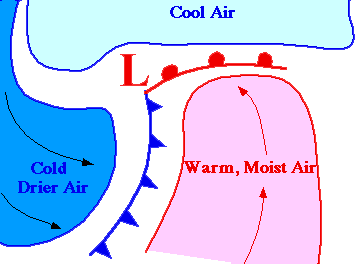|
|
. |
From The Developers...
Key words within the guide pages will be linked to other guide pages
and concept helpers...allowing the user
to access a wide variety of topics
with just a few clicks.
|
Cyclones and Associated Cold Front
leading edge of colder air mass
The diagram below shows a cyclone complete with warm and
cold fronts.
The cold front typically extends to the south from the
center of low pressure while
the
warm front extends to the east
(ahead of the storm).
At low levels, several air masses of distinctly different origin may be
found in varying parts of the cyclone. To the east of the cyclone,
the moist air mass is moving to the north behind the
warm front.
The cold front
marks the leading edge of a colder and
drier air mass. Driven by
counterclockwise winds around the
center of low pressure (shown by the arrows),
the cold air mass is dragged southward by
north and westerly winds behind the low.

Clouds and precipitation often develop along
and ahead of the cold front as the colder air mass
lifts the warm moist air mass ahead of it.

precipitation
|
|

Core Technologies
|
|


